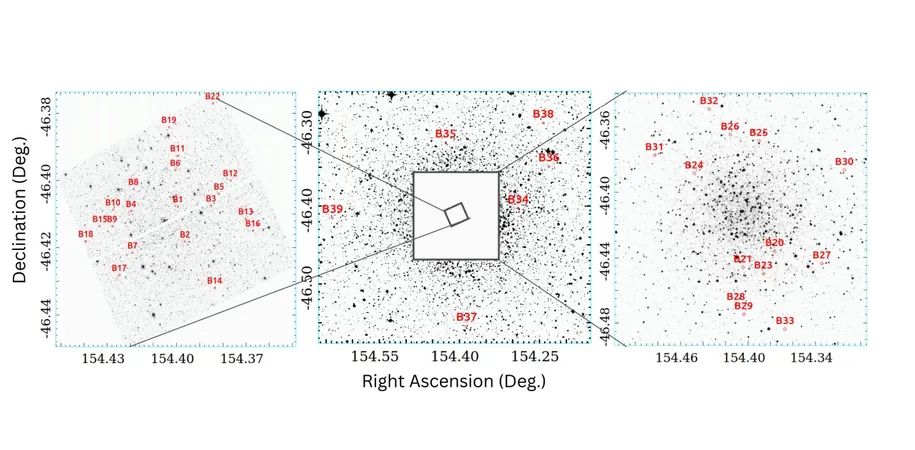
Unlocking the Secrets of Blue Straggler Stars in NGC 3201
2025-05-29
Author: Jia
Astronomers Peer into the Mysteries of Blue Straggler Stars
In a groundbreaking study using the Magellan Clay Telescope, a team of astronomers has turned their gaze toward the enigmatic blue straggler stars (BSSs) contained within the globular cluster NGC 3201. Published recently on the arXiv preprint server, this research promises to deepen our understanding of the unique characteristics and chemical makeup of this stellar group.
What Are Blue Straggler Stars?
First spotted in the 1950s, blue straggler stars are a fascinating class of main-sequence stars that stand out due to their brightness and youthful appearance compared to other stars of similar age. These stellar anomalies, located above the main-sequence turnoff in the optical color-magnitude diagram, are significantly more massive, making them valuable for probing the internal dynamics of globular clusters.
Exploring NGC 3201: A Galactic Treasure Trove
NGC 3201, also known as Caldwell 79, is a globular cluster nestled in the constellation Vela, approximately 16,000 light-years from Earth. This ancient cluster is estimated to be around 12.2 billion years old, with a metallicity of -1.59 dex and a reddening index of about 0.24 mag. Its diverse stellar population, including many blue straggler stars, makes it a hotspot for astronomical studies.
Detailing the Findings
Under the leadership of astronomer Gourav Kumawat from the Indian Institute of Science Education and Research in Bhopal, India, the research team scrutinized the spectra of 39 BSSs within the cluster. Their detailed analysis yielded substantial data, establishing a mean radial velocity of 498 km/s, effective temperatures ranging between 6,260 and 8,690 K, and a metallicity and magnesium-to-iron ratio measured at -1.42 and 0.36, respectively.
Yet More Questions Remain
Despite these impressive findings, the researchers caution that conclusions about the formation of the blue straggler stars in NGC 3201 remain elusive. "Chemical abundance is a key indicator that can help decipher the BSS formation scenario. However, the uncertainty in our derived values for [Mg/Fe] hampers definitive conclusions regarding their origins," the authors explain.
The Path Forward for Stellar Research
The authors advocate for further observations with broader spectral capabilities to unlock additional insights into the chemical abundances and atmospheric parameters of BSSs in NGC 3201. This ongoing research could unravel the complex history of these stellar giants, shedding light on their formation and evolution in the vast cosmos.



 Brasil (PT)
Brasil (PT)
 Canada (EN)
Canada (EN)
 Chile (ES)
Chile (ES)
 Česko (CS)
Česko (CS)
 대한민국 (KO)
대한민국 (KO)
 España (ES)
España (ES)
 France (FR)
France (FR)
 Hong Kong (EN)
Hong Kong (EN)
 Italia (IT)
Italia (IT)
 日本 (JA)
日本 (JA)
 Magyarország (HU)
Magyarország (HU)
 Norge (NO)
Norge (NO)
 Polska (PL)
Polska (PL)
 Schweiz (DE)
Schweiz (DE)
 Singapore (EN)
Singapore (EN)
 Sverige (SV)
Sverige (SV)
 Suomi (FI)
Suomi (FI)
 Türkiye (TR)
Türkiye (TR)
 الإمارات العربية المتحدة (AR)
الإمارات العربية المتحدة (AR)